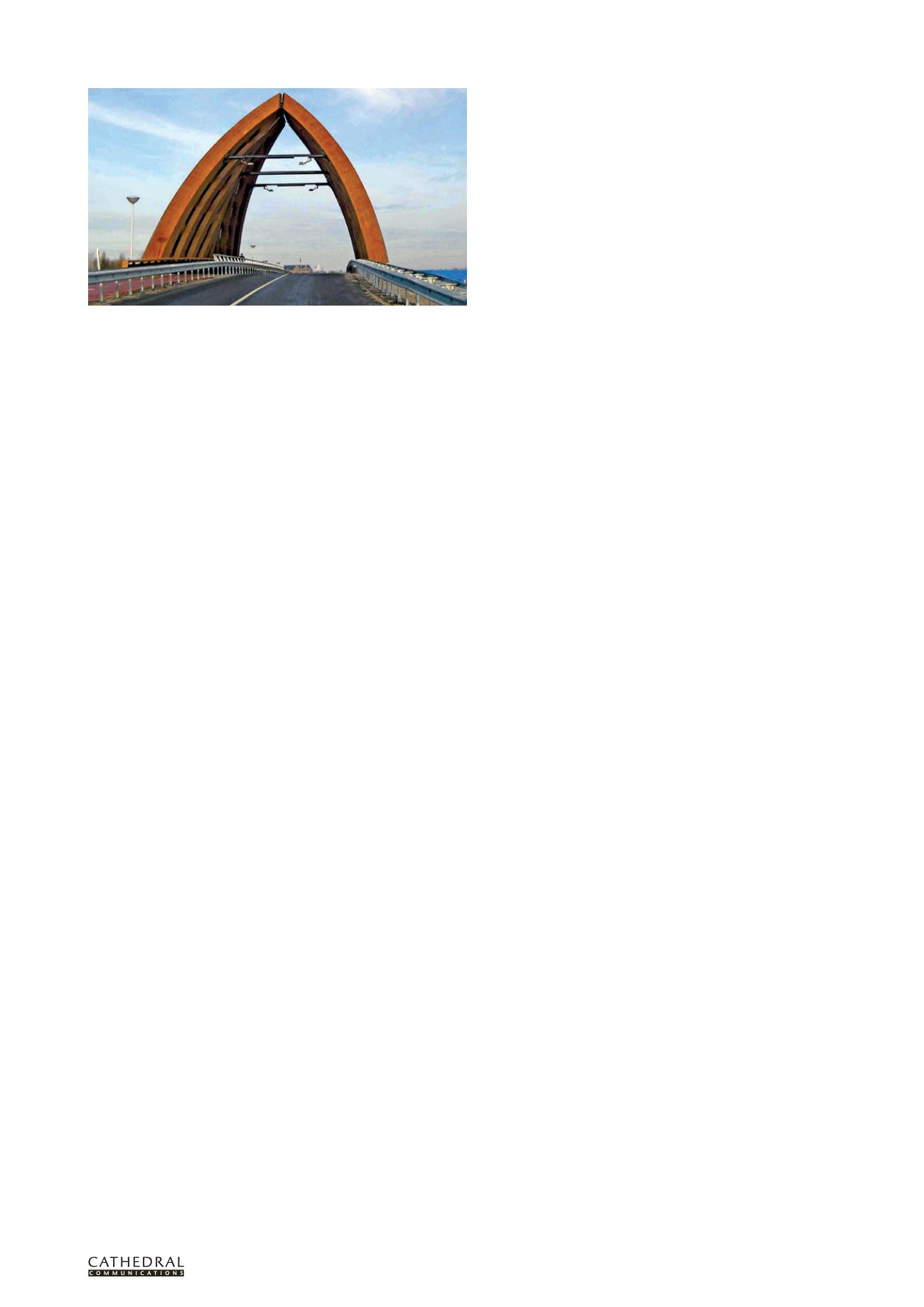
T W E N T Y F I R S T E D I T I O N
T H E B U I L D I N G C O N S E R VAT I O N D I R E C T O R Y 2 0 1 4
1 0 9
3.3
STRUCTURE & FABRIC :
ME TAL,
WOOD & GLASS
examples such as the mathematical bridge in Cambridge) and most
are quite short in span. In other countries, such as Switzerland, the
numbers run into the thousands with structural design solutions
ranging over several centuries from the simple to the ingenious. The
biggest problem with timber bridges is not their fitness for purpose
(there are many motorway and other heavy vehicle supporting
timber bridges around Europe) but the widely held perception
that timber constructions such as these are not long lasting.
The challenge therefore, for historic structures as much as for new
bridges, is to demonstrate how they can be repaired or built in such a
way that any possible deterioration is slowed down. For new bridges,
parametric computer modelling and new, engineered timber products
can facilitate the construction of durable, long-span structural
solutions never before possible. At the same time, historic bridges can
be repaired using appropriate timber species and experience-based
details that have been designed to protect the structural members from
the prevailing weather and water conditions. The reversibility of any
repairs or restoration work to historic bridges is crucially important
since the constructional and historical integrity of the structure is
part of a visible continuum and is no place for compromised or overtly
hybrid technical solutions.
Looking to northern Europe, the Norwegian Public Roads
Administration requires all bridges to be built with a 100-year
lifespan and minimal maintenance requirements, with no exceptions
for timber bridges. The solutions employed involve a combination
of constructional and chemical protection measures. The former
normally involve the use of copper sheeting on all upper surfaces, an
approach which is also used in exposed situations where chemical
protection proves unsatisfactory. There are many lessons to be
absorbed from this example. Because of their low environmental
impact, the number of structures built from sustainably sourced
timber is on the rise internationally and this is generating a future
need for good maintenance and repair practices. There is also a
growing emphasis on the need to avoid the use of chemical products
for which ambitious but often unproven claims are made.
The repair and restoration of historic structures has always
tended towards a sound understanding of the material properties and
technologies used in their original creation, which is as it should be.
The need to transfer this philosophy to the contemporary projects that
will become the historic structures of the future is the bigger, industry-
wide educational challenge, and one that needs to be confronted sooner
rather than later.
Further Information
COST (European Cooperation in Science and Technology)
Edinburgh Napier University, Forest Products Research Institute
FPS COST Action FP1101: Assessment, Reinforcing and Monitoring of
Timber Structures
PETERWILSON
is a registered architect and director of the
within Edinburgh Napier University’s Forest Products
Research Institute. The Wood Studio has a remit to promote research
and innovation in the use of timber in architecture and construction.
Accoya road bridge at Sneek in the Netherlands: Accoya is produced by
submitting radiata pine to an acetylation process which produces significant
improvements in the wood’s dimensional stability and durability.
FINE JOINERY
◾
◾
ANELAYS
William Anelay Limited, Heritage House, Murton Way,
Osbaldwick, York YO19 5UW
Tel 01904 412624 Fax 01904 413535
Email
BUILDING AND RESTORATION CONTRACTORS
: See also: profile entry in
Building Contractors, page 61.
◾
◾
B ANTONIW CARPENTER & JOINER
14 Woodseer Street, London E1 5HD
Tel 020 7241 5069
Email
REPAIRS AND RESTORATION IN TIMBER
: Established in 1976, this family
firm specialises in the repair and restoration of 18th-century buildings
to English Heritage standards. The company has extensive knowledge
and experience of listed buildings and period conservation and produces
bespoke joinery in a central London workshop, where a large library of
original mouldings and patterns is held. In situ repairs are undertaken
to panelling, cornices, architraves, sash windows, shutters, doors, hand
rails, spindles, staircases and floors and new joinery can be supplied to
match existing. Previous commissions include houses in Spitalfields,
Hammersmith, Greenwich, Holborn, Bloomsbury and Whitechapel.
◾
◾
CARREK LIMITED
1 St Andrew Street, Wells Cathedral, Wells,
Somerset BA5 2UN
Tel 01749 689000 Fax 01749 689089
Email
HISTORIC BUILDING CONSERVATION
◾
◾
DAVID BARTRAM FURNITURE
High House Farm Barn, Farm Road, Heckingham,
Norwich, Norfolk NR14 6QU
Tel 01508 548721
Email
FINE JOINERY
: Established in 1981, David Bartram Furniture has a
broad range of skills and experience in bespoke joinery, building
interiors, the design and manufacture of fine furniture and restoration
and conservation. The in house cabinet and joinery workshop is fully
equipped to undertake any commissions and aims to produce work
which exceeds expectations with the care and detail expected of fine
craftsmanship. The company has worked closely with the National Trust
for many years; conserving wooden surfaces including floors, skirtings,
doors, shutters and panelling and also making furniture to compliment
the historic collections within numerous National Trust properties.
Other services include traditional French polishing, antique refinishing,
panelling and ecclesiastical work. The workshop prides itself on a
professional and carefully thought out programme of works, using the
correct materials and methods of construction and treatment.


